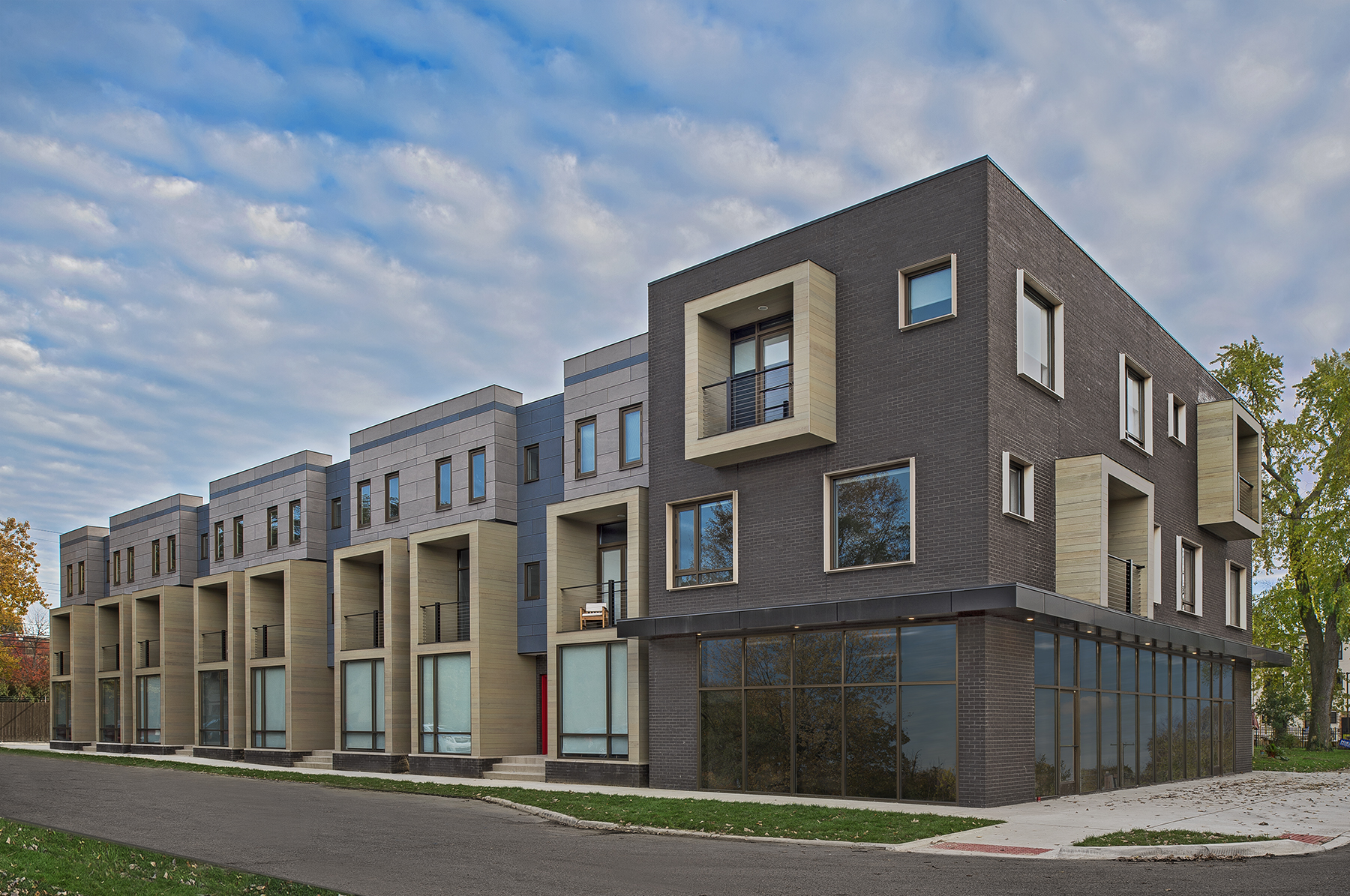Can’t tell the difference between Detroit’s new apartment buildings? Here’s why

For the first time in a while, Detroit is seeing a lot of new construction instead of rehabs or demolition. But in many cases, these buildings tend to look fairly similar.
Whether among Corktown’s turn-of-the-century Victorian homes, nestled between the stately Whitney and Kales buildings downtown or down the street from the Art Deco Fisher Building in New Center, these apartment buildings share many features: boxy, occupying most of a city block, glass commercial bays and small balconies outside most units.
Though they don’t have an official name, architects often refer to them as the “five-over-one” (or one-plus-five) building type, referring to five stories of residential built above the ground floor, often reserved for retail (though the number of residential stories can vary). The materials are also consistent: a concrete or steel first floor with wood frame above.
And they’re proliferating everywhere. “We’re seeing them all over the country,” said Todd Sachse, founder of Sachse Construction and vice president and partner at sister company Broder & Sachse Real Estate in Detroit. “They’re the dominant construction method for mid-rise residential, from Atlanta to Minneapolis to Columbus to Indianapolis. Go to those cities and you’ll see 10 times more than there are here.”
They’re popular with developers for a very good reason: cost. “It’s the most cost-effective construction system in order to get as much height as possible,” Sachse said. Broder & Sachse partnered in the development of The Scott in Brush Park, which was technically a four-over-two with one level of parking.
A 2019 Bloomberg article traces the rise of this building type to a 1996 project in Los Angeles, which wouldn’t work financially as a steel high-rise, but did as a longer building made mostly of wood. That’s because wood is cheaper than steel, both in the cost of materials and labor, since steel construction requires skilled tradespeople.
But wood is much more flammable. So to conform to building codes, these “stick frame” buildings had to have a height limit of roughly five stories above the more secure ground floor.
“The smaller the building, the more you can build it out of combustible materials,” said Betsy Williams, director of design for Hamilton Anderson Associates, a Detroit architecture firm. “If you want to make the whole thing out of concrete or steel, you can build it as tall as you want.”
They’re popular with developers for another reason: demand. Though the coronavirus pandemic has reduced demand for downtown apartments for the time being, a 2019 market study by Broder & Sachse found that occupancy rates for apartment buildings in the urban core ranged between 92% to 98%. These new buildings often have many on-site amenities, like a gym, swimming pool, individual and shared deck space and bike storage. The ground-floor programming adds even more incentives, providing easy access to businesses like fitness studios, salons and specialty grocery stores.
Five-over-ones are not a new phenomenon even in Detroit — Studio One Apartments next to the Whitney Mansion, for example, was built in the 2000s. But they’re being built with greater frequency now.
James Fidler, founding principal at City Form Detroit, said they represent the next logical stage real estate development in Detroit. “We’re finally at a point where rents for both residential and commercial buildings make new construction possible,” he said. “And stick frame gives developers the means to build a lot of units pretty inexpensively.”
(However, Sachse noted that without “significant additional incentives,” developers can still struggle to make five-over-ones work financially in Detroit’s market.)
The same elements that make the buildings more affordable, and provide a modicum of cost savings that can be passed on to renters, can also draw criticism or raise questions about how they fit into existing neighborhoods. The Corktown development, for example, is currently facing strong objections from residents who worry about increased traffic, the demolition of a historic structure and the building’s high rental prices, all of which could alter the neighborhood’s character.
“The most vibrant neighborhoods have an incredible diversity of age and income, but the way [five-over-ones] are marketed tends to be towards a very specific renter,” Fidler said. “I sort of think of them as urban dorms for young professionals because the unit size tends to be smaller and the price point tends to be higher.”
Brush Park might provide a blueprint for mid-rise construction done with more care. As part of the massive City Modern development, Bedrock Detroit constructed six multi-family buildings — all five-over-ones.
Hamilton Anderson Associates (HAA) worked on two, 440 Alfred and 124 Alfred, the latter reserved for senior citizens making between 30% to 60% of the area median income. HAA sought to make the buildings more visually appealing by varying the buildings shape through recessed balconies, an internal courtyard with street access, colorful or textured paneling and alternating floor height.
“Aesthetically, it gives the buildings more of a rhythm,” Williams said.
At 124 Alfred there are ground-floor walk-up units, creating a more natural connection to the adjacent historic Victorian.
Ultimately, said Fidler, the five-over-one is “merely a building type” and that “there’s a place for them in the urban fabric.” But at the same time, architects and developers clearly have to think consciously about how to utilize them, as one type among many, to add density while achieving neighborhood goals.
Wait! Don’t miss out on the latest insights
Sign up for Saschse Construction’s
e-newsletter below!
Featured Topics
CONSTRUCTION
ECONOMY + EMPLOYMENT
Housing Market
Multifamily + Hospitality

